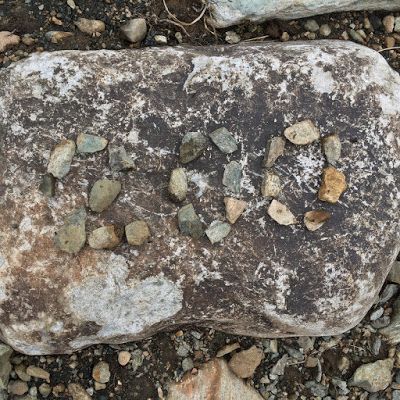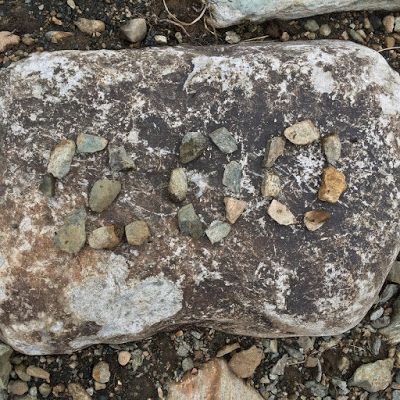The Cape Wrath Trail days 15 – 17
The Cape Wrath Trail is a long-distance hiking route in Scotland. It links Fort William with Cape Wrath, the farthest northwest point of the British mainland. Renowned as one of the toughest long-distance walks in the UK, it is not waymarked, has no single recognised route, and there is frequently no actual path underfoot. Due to its informal nature, the length of this trail varies. Most thru-hikes are around 230 miles in length.
My hike of the Cape Wrath Trail took place between June the 3rd and June the 22nd 2015, and consisted of eighteen days of walking and two rest days. My route was 241 miles in length and was based on the itinerary laid out in the popular Cicerone guide by Iain Harper, with a few small modifications. I used the new Harvey Cape Wrath Trail maps for navigation.
The CWT is one of the finest foot journeys of its kind in the UK and takes the hiker through some magnificent wild locations. Its tough and frequently trackless nature makes the route I took potentially tricky in poor weather, requiring good navigational skills, a high level of fitness, and the ability to cope with hazards such as the crossing of swift-flowing rivers. But it’s also truly magnificent. In this series of blog posts I will tell the story of my CWT adventure.
My original plan for days 15 and 16 had been to take the east route round the back of Ben More Assynt. This isn’t the main route in the guidebook, but is presented as a wilder alternative stage for those who have no need for the amenities at Inchnadamph. I’d only been away from Ullapool for a day so had no wish to return to civilisation so soon.But the weather was pretty bad – so windy and wet, in fact, that I knew at once all hopes of walking the harder alternative stage were pointless. I’d found it very difficult to locate suitable campsites on the CWT. It was almost impossible to find places that were flat enough, smooth enough, sufficiently well-drained, and sheltered – even satisfying just one of those conditions was often a struggle. I pictured myself trying to pitch the Notch in galeforce winds on some heathery ledge, or in the middle of a bog out of desperation, and knew I had to modify my plans.So I made my mind up to tackle the pass of Breabag Tarsainn instead. First I had to make it along the length of Glen Oykel.
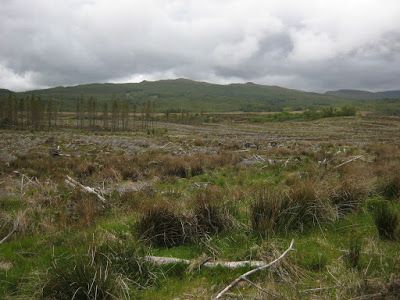 |
| Typical Glen Oykel scenery |
The previous day had been less spectacular than an average CWT section, but Glen Oykel was the low point of the entire route. At the time, I remember feeling a little guilty that I could admit such a thing, but there you have it: combine rain with a long grind along landrover tracks, through miles of clear-felled forestry plantations, and it’s going to compare poorly with all the amazing sections I’d passed through over the previous two weeks.
I didn’t really mind the hard roads or the bad weather that much; what I didn’t like was the constant reminders of civilisation. I’d passed through so much relative wilderness, where mankind’s impact is everywhere but very subtle, and you can ignore it if you try. But in Glen Oykel I felt that nature was being held hostage and used by humanity on a horrible scale. It’s no different to any other part of the British countryside, of course, but I didn’t want to wake up from the dream – and there I saw reminders everywhere that the majority of human beings see nature as a resource to be exploited, not a priceless treasure to be defended.
I passed through industrial cattle farms and mile upon mile of felled woodland. Despite a few breaks in the weather, it was generally grim head-down walking in heavy rain, with some massive gusts of wind thrown in for good measure.
The River Oykel itself was the only part of that day’s walk that I really enjoyed, but even that was tamed for the purposes of commercial fishing. And logging operations meant a convoluted and annoying diversion to the trail.
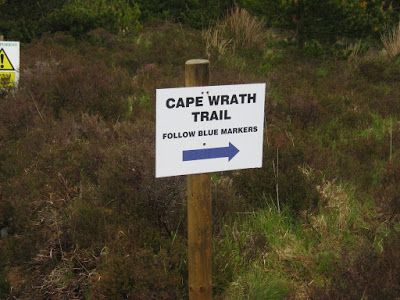 |
| The only CWT trail marker I saw on the entire journey |
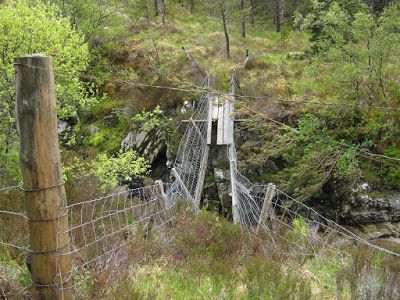 |
| The worst bridge on the Cape Wrath Trail |
I spent an hour or two flailing around in bogs, thickets of heather, and trying to dodge “NO PUBLIC ACCESS! LOGGING OPERATIONS!” signs. It was not a high point of my CWT experience.
Fortunately I was out of the worst of it soon enough and could see mountains in the distance. Although my mileage for the day had not been great, the weather was getting windier and I started to think about finding somewhere to camp. I was keen to draw a line under Glen Oykel and move on to better parts of the trail.
By this point the high wind was a serious cause of concern. I knew I had to find somewhere sheltered, so I spent some time in the forest off-trail looking for a suitable glade. Eventually I found just the spot: a grassy meadow in the curve of a burn, sheltered on all sides. It was actually a delightful campsite and the best wild camp of the entire trip. By the remains of a fire I could tell that others had camped there before.
Although I could hear the gale tearing over the treetops, hardly a breeze ruffled my flysheet and I slept better than expected.
Day 16 – June the 18th
10 miles
I awoke to a moment of pure magic: a swoosh and a flap of mighty wings, followed by the unmistakable yip! yip! yip! of a golden eagle. A shadow flitted above my tent. The king of birds had just swooped over my forest glade, but sadly I didn’t catch a glimpse of it.
It was another morning of packing up inside the tent to avoid the rain outside for as long as possible. When I finally emerged, I found that the burn encircling my meadow had risen by about a foot overnight thanks to the rains.
Upper Glen Oykel – which is much, much wilder than the forested lands lower down – proved to be a brutal struggle and the hardest section of the entire trail since those early days through Knoydart. The weather was so bad that I didn’t take my camera out all day, and I don’t have a single photo from June the 18th.
Although I followed a good path for a couple of miles, it soon disappeared into the bog and I had to – you’ve guessed it! – follow contour lines and perform other navigational magic to get me to the summit of the pass in the terrible visibility. This was very much a ‘compass-in-hand’ day, and is one of the stretches of the CWT that will punish the unskilled (if they manage to get this far). It’s incredibly easy to find yourself following vague tracks and accidentally climbing towards Dubh Loch Mor when you should be contouring much lower, following the rougher ground.
Despite the rainfall, the rivers weren’t too bad in Glen Oykel although I did get pretty wet fording one of them; by this point in the trail I had given up on removing socks or rolling up trousers when wading rivers. The final climb to the bealach was steep, rough work, and by the time I reached the top of the pass I was absolutely soaked to the skin. My waterproof trousers had leaked badly and water had got under my jacket too. I was later to discover that about a litre of water had somehow penetrated my rucksack cover and pooled in the bottom of my pack. It was just one of those days when it’s impossible to stay dry. And it was cold, too – at the top of the pass the rain briefly turned to wet snow.
The descent from the bealach, picking its way down the western slopes of Conival, was even tougher than the ascent. Visibility was as poor as I’d ever seen it during the summer months on a mountain, and it was very easy to miss the faint path that wove a stealthy way between crumbling cliffs. Lose this path and you’ll find yourself in extremely serious terrain. On one occasion I found myself looking down a 100m+ vertical drop, wondering where the hell the path had gone.
When I made it past the cliffs there was another vast bog to negotiate, made confusing by complex contour lines. Fail to take compass bearings here and you could end up losing hours of time and a great deal of energy.
The crossing of the River Traligill was the most difficult moment of the day. This is a serious watercourse and, in the conditions, I had to take some time to select the right crossing point. I ended up traversing the steep rocky sides of a ravine as I contemplated several possible places, each of which looked worse than the last. In the end it came down to jumping between two rocks spaced further apart than I’d have liked – the consequences of getting the leap wrong would have been catastrophic – but it was either that or risk wading a torrent that could easily have swept me away.
I survived the river crossing and shortly afterwards met another walker, called Andrew, who was on his way down from Conival. Chatting to another human made me feel a little better after such a punishing crossing, and we promised to meet at the hotel bar that night.
When I got to Inchnadamph I knew at once that I would need a roof over my head that night. I was simply too soaked and cold to even contemplate camping, and I doubted I’d be able to find anywhere acceptable to camp anyway; every inch of ground was utterly waterlogged. After finding the bunkhouse and standing shellshocked and dripping on their doormat for a few minutes while I figured out that they were full for the night, I made my way to the hotel. Sod it, I thought; I’m checking in to the hotel. I need this.
The hotel was a haven. I was amazed that I had an entire room to myself with a bed, a chair, and a bath! Such incredible luxuries! After washing my clothes and sending them to the drying room, I had a bath and felt richer than any other human being on Earth. The staff of the hotel were friendly and welcoming, being used to thru-hikers, and after drying out I spent a few pleasant hours in the bar talking to Andrew, the other guests, and the barman.
The barman was an experienced hillwalker and knew all about the CWT, the Assynt backcountry, and the hardships of long-distance hiking. He told me that a number of CWT thru-hikers had passed through Inchnadamph that month, but nowhere near the fifteen a week I had heard reported at the start of the trail. In fact, he told me that many hikers had failed to claim resupply boxes sent to the hotel.
‘A lot of hikers have dropped out this year,’ he said while pouring me another pint of An Teallach. ‘The trail is getting busier, but it’s catching people out. And the weather hasn’t helped either.’
I couldn’t help but agree with him.
I hadn’t intended any hotel stops when I started my hike, but in the circumstances a stay at the Inchnadamph Hotel was exactly what I needed. I didn’t realise just how much the crossing from Glen Oykel had taken out of me until I collapsed, exhausted, in my bed not long after 9 p.m.
Day 17 – June the 19th
12 miles
I left Inchnadamph in improving (but still damp) weather, feeling considerably restored. I’d been looking forward to this section of the trail for a long time – it would take me through some splendid wild country, and past the 200-mile mark.
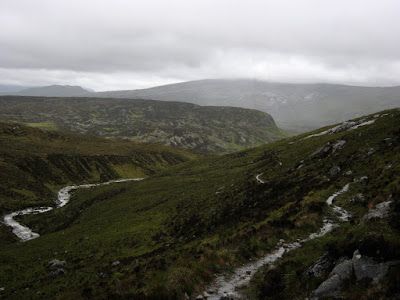 |
| Leaving Inchnadamph on a good path |
The first few miles felt easy compared to what I’d dealt with the previous day. I climbed the hill rapidly and was soon making the final ascent to the pass of Glas Bheinn.
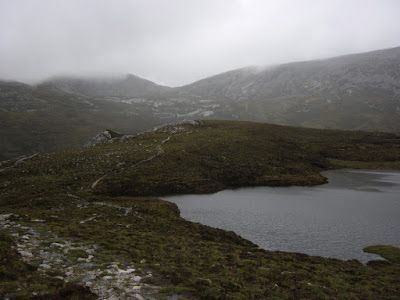 |
| The pass visible in the far distance |
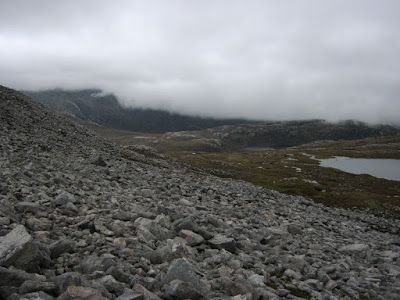 |
| My first glimpse of the wilderness beyond |
At the top of the pass, the terrain made an abrupt change from open, scooped-out corries to far more complex and rugged topography. In the words of the guidebook, ‘As you climb back out of Inchnadamph … you’re entering some of the best mountain country in the world.’ It looked good, and it got better with every mile I walked.
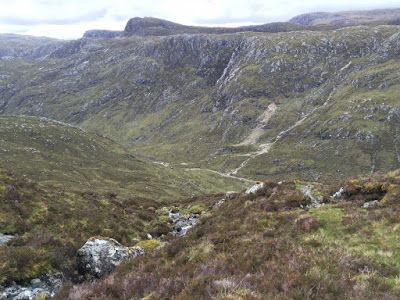 |
| Dropping down to the magnificent canyon of the Leitr Dubh |
A path took me through complex terrain to the cliffs near the top of Eas a’Chual Aluinn, the highest waterfall in the UK. I then dropped straight down steep ground next to a burn and crossed the river, which I then followed north towards Loch Beag. Leitr Dubh was simply majestic, a vertical-sided canyon through which waterfalls thundered – and no paths to be seen anywhere. This section of the trail represented the CWT at its very best.
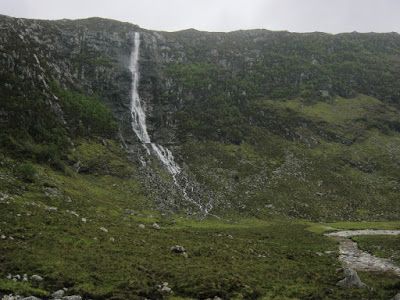 |
| Eas a’Chual Aluinn |
After a while I caught my first view of the mighty waterfall. It astonished me. If I had thought the Falls of Glomach impressive, Eas a’Chual Aluinn made ten times as big an impression. In fact, the entire glen at that point felt more like an otherworldly landscape from Middle Earth than an actual location in Scotland.
I felt a little like a hobbit questing through the wilds, and found myself humming the soundtrack to The Lord of the Rings as I walked.
At the outflow of the Abhainn an Loch Bhig river, I contoured around a small headland into Glen Coul, where I stopped for a few moments at the remote bothy. This is actually the location of the most remote war memorial in the UK. I could see it standing proud on a small knoll not far from the buildings.
Onwards! I had one more headland to cross before I could call it a day. Mileage would, again, be low – but over such rough pathless terrain I had no quibbles with stopping early. I planned to stop at the Glendhu bothy a few miles to the north. I only had a few more days left on the trail, and wanted to enjoy my remaining time as much as possible.
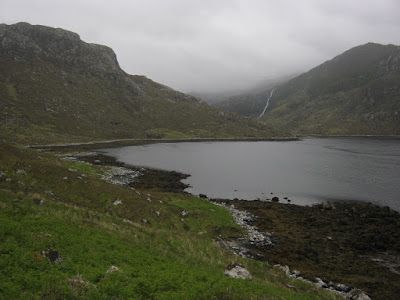 |
| Looking back to Leitr Dubh and the falls |
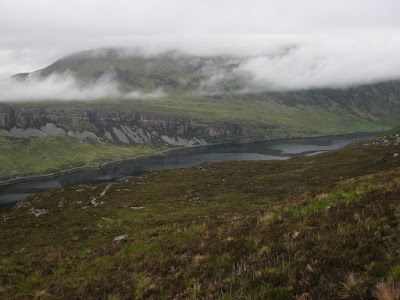 |
| Crossing the headland and looking towards Loch Gleann Dubh |
The headland proved to be pretty tough going – a steep landrover track to begin with, so steep that I doubted any vehicles could successfully climb it, followed by rough trails over moorland and through birch woodland that clung precipitously to the side of the mountain.
And I passed trail mile 200. Hurrah!
When I finally reached the bothy at Glendhu, I felt more than ready to call it a day despite only having walked twelve miles. It felt more like a Knoydart day – not quite as tough as the crossing from Glen Oykel, but challenging for different reasons. I got a fire going and dried out my shoes.
As I read the bothy book and picked out the scant few entries from the CWT hikers who had made it this far, it started to dawn on me at last that I would make it to Cape Wrath, and that the final moment of my adventure was rapidly approaching. I had less than forty miles left to walk to the farthest northwest corner of the British mainland. In a few days my life on the trail would be over.
In the next blog post I’ll describe my final three days on the trail: a road-walking diversion due to injury, camping at Sandwood Bay, nearly getting bombed by the RAF, and the moment of triumph when I reached the lighthouse.
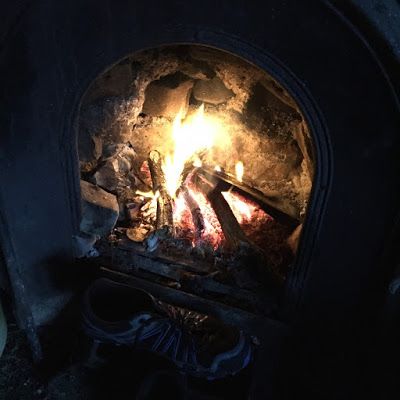 |
| Tranquility at Glendhu bothy |
Alex Roddie Newsletter
Join the newsletter to receive the latest updates in your inbox.

